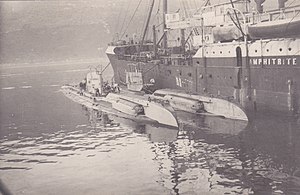This article needs additional citations for verification. (June 2024) |
 Two Type UC II submarines alongside Austro-Hungarian depot ship Amphitrite at Gjenovic, Bocche di Cattaro, in the Adriatic Sea
| |
| Class overview | |
|---|---|
| Builders | |
| Operators | |
| Preceded by | UC I |
| Succeeded by | UC III |
| Cost | 1,729,000–2,141,000 German Mark |
| Built | 1916–1918 |
| In commission | 1916–1918 |
| Planned | 64 |
| Building | 64 |
| Completed | 64 |
| Lost | 46 |
| General characteristics | |
| Type | Coastal minelaying submarine |
| Displacement | |
| Length | 49.35–53.15 m (161 ft 11 in – 174 ft 5 in) o/a |
| Beam | 5.22 m (17 ft 2 in) |
| Draught | 3.65 m (12 ft) |
| Propulsion |
|
| Speed |
|
| Range |
|
| Test depth | 50 m (160 ft) |
| Complement | 3 officers, 23 enlisted |
| Sensors and processing systems | 1 periscope |
| Armament |
|
Type UC II minelaying submarines were used by the Imperial German Navy during World War I. They displaced 417 tons, carried guns, 7 torpedoes and up to 18 mines. The ships were double-hulled with improved range and seakeeping compared to the UC I type.
If judged only by the numbers of enemy vessels destroyed, the UC II is the most successful submarine design in history: According to modern estimates, they sank more than 1800 enemy vessels.[1]
List of Type UC II submarines
[edit]There were 64 Type UC II submarines commissioned into the Imperial German Navy.
|
|
Wikimedia Commons has media related to German Type UC II submarine.
References
[edit]Citations
[edit]- ^ Helgason, Guðmundur. "U-boat War in World War One". Uboat.net.
Bibliography
[edit]- Gröner, Erich; Jung, Dieter; Maass, Martin (1991). German Warships 1815–1945, U-boats and Mine Warfare Vessels. Vol. 2. Translated by Thomas, Keith; Magowan, Rachel. London: Conway Maritime Press. ISBN 0-85177-593-4.
- Conway's All the World's Fighting Ships 1906–1921